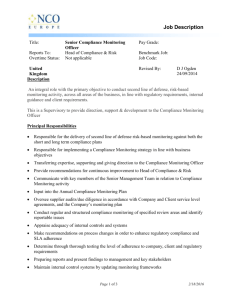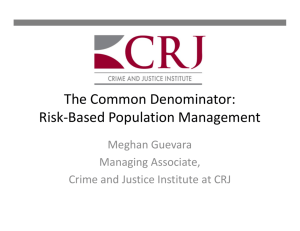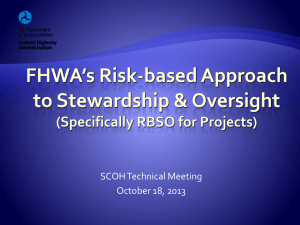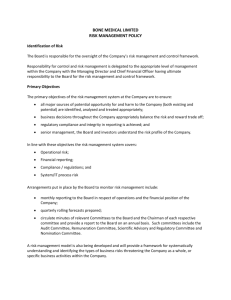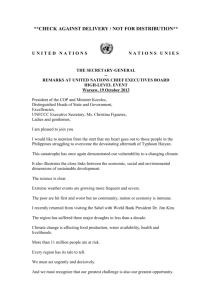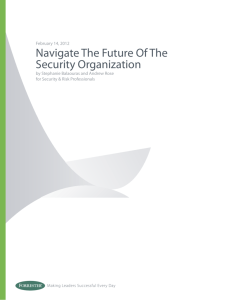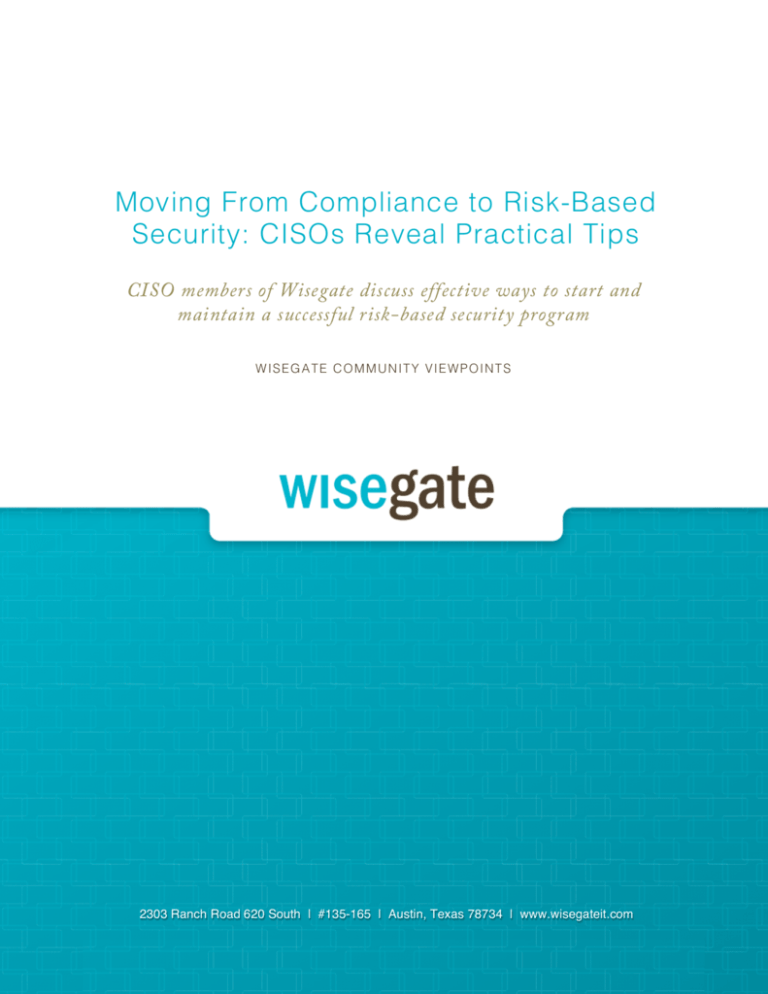
Moving From Compliance to Risk-Based
Security: CISOs Reveal Practical Tips
CISO members of Wisegate discuss effective ways to start and
maintain a successful risk-based security program
WISEGATE COMMUNITY VIEWPOINTS
2303 Ranch Road 620 South | #135-165 | Austin, Texas 78734 | www.wisegateit.com
22
Introduction
Security managers are working with senior executives and their counterparts in groups
across the organization to move from a compliance-based approach to information security
towards a risk-based approach. The shift requires senior management and the C-suite to
think differently about risk and stop handling compliance as a checklist.
Many industries are under regulatory pressure, but the federal government is also pushing
forward risk-based frameworks. Organizations interested in retaining government contracts
will need to ensure they have the controls and processes in place to meet requirements
outlined by risk-based frameworks such as FISMA and NIST.
The shift to a risk management approach has been brewing for some time. In a previous
Wisegate report titled, “CISOs Share Advice on Managing Both Information Security &
Risk,” CISOs from top companies discussed the impacts of evolving job requirements as
they take on a more strategic and proactive role in risk management and privacy. Today’s
CISOs are being asked to prioritize risks—by identifying which ones need to be addressed
and which ones should be accepted as the cost of doing business.
In the latest Wisegate discussions, security executives across industries broadened
previous conversations by taking a more in depth look into the challenges of shifting
towards risk-based information security. While no two risk programs are identical, Wisegate
members identified the following key takeaways.
»
Compliance becomes just one factor in the risk profile. Even in a risk-based
program, compliance doesn’t go away entirely. The regulations are still there, but
department heads and managers have to start thinking in terms of acceptable risk
levels versus compliance requirements to mark off a checklist. It's a change in
language, and the moment when everyone understands the difference is an "ahha!" moment for the entire organization.
»
Tolerance for risk changes over time. The organization's risk tolerance is
dynamic and fluid. The assessment plan and risk profile indicates the
organization's risk acceptance level at a point in time, but it is expected to change.
It is also difficult for organizations to properly assess risk beforehand; frequent
conversations about what department heads and senior management are
comfortable with promotes awareness across all lines of business.
»
Making risk management work. Risk management can be broken down into three
distinct areas: strategic, tactical and operational. As organizations move to a riskbased approach, they can explore assessment platforms, work to create risk
profiles and partner with third-party providers to perform risk assessments.
Moving From Compliance to Risk-Based Security
2
Compliance Becomes Just One Factor in the Risk Profile
Security professionals have to engage business counterparts in frequent discussions about
risk and compliance, and understand that complying with a regulation doesn’t necessarily
equate to being secure. There is also a need for multiple, ongoing conversations that
address how compliance fits within the risk framework.
For many Wisegate members—which include senior security executives in leading and
major corporations across various industry sectors—compliance was a good starting point
to begin the conversation.
A CISO of a health insurance provider commented, "We have patient information, so HIPAA
and HITECH are daily conversations around here. Having management understand the
value of going beyond compliance requirements to reduce our overall operations risk was
invaluable.”
When asked why their organizations were implementing a risk management program,
Wisegate Members unsurprisingly named compliance requirements as their primary
reason.
What are the top drivers for your Information Security / Risk
Management program?
Wisegate Community Viewpoints
3
For organizations with federal contracts, realizing the need to be FISMA-compliant helps
add momentum to their programs. While compliance remained the top driver, many
organizations also experienced an "ah-ha!" moment that drove home the importance of a
risk-based approach, according to some CISOs.
When Bad News Can be Good News—Negative Incidents as a Driver for
Change
"Business people need to feel the pain. If you’re unfortunate enough to have something like
a big data breach that makes the headlines, then that just might be the ah-ha! moment that
moves the company towards a risk-based approach. But hopefully, you can address this
before you get to that point," commented an information security manager from a large nonprofit during a Wisegate roundtable discussion.
Looking at what happened to their peers can also make senior management pay attention.
"The biggest ah-ha! moment was when other institutions had issues that caused them bad
press, monetary fine, or a combination of the two—that certainly made people stand up and
take notice," said one higher education CISO.
While negative incidents get the organization talking about risk assessments, the catalyst
doesn’t necessarily have to be a data breach. An internal audit flagging poor access
management and other regulatory drivers can also improve funding for risk management
projects.
Mapping Compliance Requirements to Risk Frameworks
Not all frameworks and regulations are created equal. Some provide stronger controls and
frameworks for implementing security. Others have boilerplate controls that are too vague
to be of any use. One recommended approach is to first understand what controls the
organization needs and then figure out whether they are already in place by performing a
risk assessment.
A CISO of a healthcare organization described during a roundtable discussion how an
insurance company mapped HIPAA and HIPAA HITECH requirements against the controls
required by NIST800-53:
"A mapping shows the controls that we have in place, such as access controls, and the
relevant HIPAA reference. That’s been very helpful from the auditor standpoint, but from an
operational standpoint, we aren’t focusing only on HIPAA."
A security executive from a medical services organization compared compliance to a lens,
saying the set of controls can be viewed from a compliance perspective as well as risk.
After verifying a system was compliant, the next step was to assess actual security.
Moving From Compliance to Risk-Based Security
4
"The first lens looks at the control and says, 'yes, it’s there,' or 'no, it’s not or it’s not
applicable.' That’s the compliance way of asking, ‘Hey, is there a lock on the door?' 'Yes.'
Then I go back and I grade it again for maturity, saying, ‘That lock is kind of weak. I’d rather
move these systems from this office with the weak lock into a bunker that has armed
guards.' As far as the law is concerned, my system’s behind a locked door, only three
people have a key, and I’ve got tracking to see who can get in there, but when I look at that
and have a conversation with my CIO, we say, 'That’s just not as secure as we’d want it to
be. We need to move these systems.'"
The first assessment determines where the controls exist and creates a gap analysis to
identify the missing areas. The second assessment looks at the controls that need to be
there and assesses whether they are sufficient. If not, the security team has to assess the
risk of not using the stronger controls.
Tolerance for Risk Changes Over Time
It's impossible to apply security controls across the board. No one has the resources to do
that nor would it necessarily be good for the organization as a whole. So security
professionals must conduct risk assessments to identify areas that are high priority for the
organization. The problem is, not many business stakeholders—department managers,
team leads, and senior executives—are used to thinking about security as part of a risk
conversation.
Use a Baseline Document as a Starting Point
Several security executives commented that their counterparts in other parts of the
organization didn’t have a clear view of what was an acceptable level of risk and couldn’t
define their risk tolerance until they could look at something concrete. Many CISO members
of Wisegate agreed that having a document as a starting-point facilitates these discussions.
But it was also cautioned, “Don’t try to get it perfect. Don’t try to cover everything. It’s much
more important to get a starting point and start the discussions.”
Once the organization creates an executive risk baseline document with the controls
identified and the baseline clearly marked, then security and the leaders of the various lines
of business can sit down each month and decide which controls may need a second look.
Through the document, the stakeholders and senior managers can clearly see what it
means to ease up on some controls and make changes as necessary.
Wisegate Community Viewpoints
5
Actual Incidents Help Illustrate Risk
One security manager in the healthcare sector discussed how their organization's tolerance
for risk changed after several laptops were stolen. Once there was a clear example of risk,
it was easier to understand the risk of not doing anything.
"We had a couple of laptops stolen. Fortunately, none of them had HIPAA data, but it was a
wakeup call, a shot across the bow. If that had happened in another division, we’d have a
crisis. Their risk tolerance changed instantaneously because the abstract became real."
A director of information security at a financial services firm described how the senior
executives in his organization wanted to be notified about everything.
"When we were deciding what to escalate up to our executive team—what level of
information and what metrics—they initially said they wanted to see everything. When we
showed them what ‘everything’ was, they understood the volume. The conversation then
became focused on finding the right level, such as, ‘The system is down for 10 minutes. We
don’t really care about that. Let us know if it’s down for an hour.’”
Risk tolerance is hard to define, which is why it's important for the security team to work
alongside line of business partners so that they can collectively work through the
assessment and keep the conversation going on a regular basis. Definitions, thresholds
and tolerance levels eventually get clarified, and the division manager and executive
leadership will know when something carries too much risk.
In a ideal scenario, the security team would work with all levels of the organization—starting
with the C-suite, then the managers and continuing all the way down to the end-users—to
clarify the balance between security and risk, and to understand what makes users scream
in frustration.
"The exercise consists of going through and tightening the screws and saying, 'If we set this
up in the way that it makes the most sense based on security, we would have three
gateways and it would require three log-ins.' Then you’ll get feedback from the executives
saying, ‘We don’t want to remember three different log-ins.'"
A director heading up security at an investment bank said, "Looking at impact levels—what
people are willing to accept—sometimes is the right place to start."
Some Employees are Riskier Than Others
Every employee doesn't pose the same level of risk to the organization. Executives can
have a higher acceptable risk profile—such as the ability to run unapproved software,
Moving From Compliance to Risk-Based Security
6
share data and use more assets—than end-users or lower-level managers. The risk profiles
can be organized into a color-coded organizational chart like the one shown below.
Assign Color-Coded Risk Profiles Across the Organization
This particular type of organizational chart is a visual way to get different members of the
company thinking about risk. Every name on the organizational chart hierarchy is inside
either a red, yellow, or green box on this chart. The colors indicated the amount of risk each
person pose to the company (red—show-stopper; green—no/low risk).
Making Risk Management Work
During the roundtable discussions, Wisegate members stressed the importance of having
frequent discussions about risk tolerance and existing controls, even on a monthly basis.
The conversation needs to involve key stakeholders in the organization, including the CEO,
COO, CFO and other C-suite executives, human resources, IT, business support and
business unit executives.
Risk management programs need to have top-down buy-in, and a risk executive must be
willing to take charge of the entire program.
Wisegate Community Viewpoints
7
As one security director said, "If you have executive support, risk management can work,
but it’s not something that you’re going to be able to just flip a switch and have it start
working. There are a lot of conversations that need to occur, and people need to agree on
baselines, scoring and a lot of other elements."
Collect Data Regularly for Most Up-to-Date View
In the discussions, CISOs and director-level security professionals said there should be at
least two full-blown assessments a year, one of which should be a true penetration test and
the other scrutinizing all existing controls.
The results of the penetration test, financial control audits, system tests and evaluation, and
any other assessment data should be combined to get a full overview of the organization.
The assessments help each line of business understand the risks associated with their
projects and initiatives and ultimately transforms what used to be just a compliance audit
into a risk management program.
A senior security executive described the importance of having an initial risk questionnaire
for a manager to complete when starting up a new project so that risk can be adequately
assessed. Answers to questions about types of data being accessed, architecture, and
user access help the organization create a preliminary risk profile for the new initiative. The
questionnaire can also be overlaid against NIST or similar controls.
"We started by saying, ‘What do we need to know before we can develop a risk profile? And
what are the red flags—those things that get our complete undivided attention if somebody
says it during a new project meeting?’ We broke it down into five or six questions and said,
'If we get certain answers to these five or six questions, we will need to be more involved
with the project going forward.'"
Even if the resulting risk profile doesn't trigger a flag, everyone can proceed with full
awareness of the potential risk—while still small—associated with the new project.
Treat Risk Management as an Evolutionary Process
Wisegate members agree that it is helpful to approach the transition from compliance to
risk-based security as an evolutionary process. Wisegate member Jeff Bardin identifies, in
the graphic below, different levels organizations go through while building processes and
frameworks.
Moving From Compliance to Risk-Based Security
8
Risk Management Evolution
Jeff explains, “Risk is just a phase in the evolution of security. Once built in, security will be
just as seat belts, brakes and air bags are on automobiles—standard features and
functionality. Risk today is no more than an opportunity for the organization to waive due
diligence and due care.”
Wisegate Community Viewpoints
9
Approach Risk Management from Varying Points of View
Risk management should be looked at from varying points of view including: strategic,
tactical, and operational.
Three Levels of Risk Management
Risk management from strategic, tactical, and operational points of view.
Strategic—At this level, focus is on the lines of business and their
individual objectives. The question to ask is, “How it will affect the
company's three-year and five-year plans?” Security managers should sit
1
down with their counterparts across the organization—including HR, IT,
finance, operations and other divisions—to talk about existing risks.
Everyone should weigh in on what they feel is acceptable, transferable or
can be mitigated. The goal is to create a thorough risk impact analysis so
that executives know the objectives.
Tactical—The security team is primarily concerned with performance and
how the organization is doing against the risk controls, but the business
objectives are still paramount. Managers and executives may be willing to
2
take more risks, but the auditors generally suggest a more cautious
approach. Some point between the two is the baseline for the
organization’s acceptable level of risk. With the baseline in place, it's time
for the executives to discuss in which areas they are willing to take on
more risk.
Operational—This is where risk assessments, SDLC, continuous
3
monitoring, risk profiles, and controls are all built. The operational level
should consider what compliance controls are in place, find the gaps,
and identify new tools to add.
Explore Risk Assessment Methodologies and Tools
Security teams are adopting various governance and control frameworks, and it was clear
at the roundtables that members are using a mix of controls and frameworks, instead of
relying on just one. Examples include using modified ISO 27000 controls alongside CoBIT.
The HITRUST framework is already mapped to ISO, NIST 800-53, PCI, and HIPAA/HITECH,
making it easier to work with.
Moving From Compliance to Risk-Based Security
10
Which governance or control frameworks have your organization
adopted, even if loosely (assume centralized model)?
A director of identity access management at a financial institution said:
"The reality of these standards and others is that we found adhering to some of the controls
next to impossible for various reasons (culture, business maturity, lack of mature SDLC,
etc.) so we usually implemented some and others were home-grown based on a good set
of policies, standards, and procedures... 'loosely coupled' is a good way to put it."
In the medical sector, there is no single framework that contains all the compliance rules,
prompting the security team to identify a handful that could be cobbled together to meet all
requirements. "I use the NIST framework with the ISO controls overlaid with HIPAA controls,
PCI controls, a couple of contractual obligations and I've created a framework that's got
about 177 controls."
CISOs are adopting various risk assessment methodologies and tools to conduct audits
and assessments. The results are in line with the earlier risk management report.
Wisegate Community Viewpoints
11
Which IT risk assessment methodologies does your organization use,
even if loosely?
In an online poll, Wisegate members identified the following risk assessment tools and
vendors as being helpful: Citicus ONE, WolfPAC, OCTAVE Allegro, and Binary Risk
Assessment. Some of the CISOs said they relied on homegrown audits using ISO 27000 for
a framework because they weren’t impressed with the level and depth of content from
commercial providers.
Wolfpac appeared to be commonly used by financial institutions to compile and document
risk assessments. It allows for the production of a comprehensive risk assessment report
that can be used for regulatory requirements as well as an executive summary that can be
used for board reporting. Some CISOs praised the platform for its comprehensive features:
"Wolfpac should be a jumping-off point to address regulatory issues then expanding upon it
into a comprehensive IT Risk Management program. It is definitely not a cure-all but if small
or mid -size financial institutions aren't using anything and were looking for something to
address regulatory concerns or cited contraventions, I would recommend it."
Others remained skeptical of WolfPAC's capabilities.
Moving From Compliance to Risk-Based Security
12
"One thing I have noticed with Wolfpac is that it is not quantitative in any shape or form. It is
opinion based Q&A that leads to the assessment. Unless it has changed, that was my
impression as recently as last fall. Therefore, I don't believe it is in fact comprehensive. It
does have acceptance with auditors but this demonstrates a problem overall with how
things work. I have seen financial organizations use Wolfpac and pass their audit /
assessment, but have significant technical and procedural issues bordering on material.
Then again, this can be said about many methods/tools (Garbage In, Gospel Out)."
While OCTAVE Allegros was also a popular choice, it may be too complex for some
organizations.
"In terms of straight IT risk assessments, we have used OCTAVE Allegro in the past but
have found even this simplified version of OCTAVE can bog down small(er) IT departments.
Because of this, I have generally gone with an outsourced and slightly less complex
solution."
Other third-party risk assessment providers members had success with included Trace
Security, KCA Infosec Assurance, Verizon Business, SecureState, NetSpi, Deloitte, Fish Net
Security, Accuvant, and Stalwart Systems.
Tips for Success
Business units, such as human resources, IT, support staff, business unit leads, and even
end-users can be suspicious of risk management programs--considering them to be a form
of witch-hunt through which security teams were looking for problems, CISOs said. The way
to diffuse this tension is to make the conversation inclusive and collaborative. Find out what
is important to the end-users and their manager and what slows them down while working.
Use that as a starting point to answer why things have to be a certain way and how things
can be better.
"Ask end users, ‘What is it about your department and your activities that you’re worried
about?’ There’s always one little thing out there that makes the department think, ‘Oh, my
God, if this fails, we’re screwed,’" said a senior security manager.
"If we come to a point in time where the business is surprised or perceives that we’re
basically saying, 'You can't do something’ or ‘What you’re doing is wrong,' as a business
leadership team, we’ve failed."
Wisegate Community Viewpoints
13
In Closing…
From the Wisegate roundtables, it was clear that risk management programs provide
organizations with a lot of flexibility, but implementation still requires a tremendous amount
of effort. A risk-based approach doesn't eliminate compliance requirements, and C-level
executives, security managers and division heads have to learn to communicate their
objectives so that collectively everyone can agree upon the right balance. Risk
management requires buy-in from the top-down so that there is support for new initiatives
and processes.
Being part of the Wisegate expert network keeps senior IT practitioners abreast of evolving
strategies and informed on which approaches other CISOs find effective. An in-depth
discussion of the challenges and tactics that can be helpful to explore when moving from
compliance to risk-based security continues at Wisegate.
Wisegate is an IT expert network and information service that provides senior-level IT
professionals with high quality research and intelligence from the best source available—
the collective knowledge of IT leaders from across the industry.
Through live roundtable discussions, detailed product reviews, online Q&A and polls, and
timely research reports, Wisegate offers a practical and unbiased information source built
on the real-world experience of veteran IT professionals. No analyst theories or vendor bias
to cloud the information, just clear and straightforward insight from experienced IT leaders.
!
Would you like to join us? Go to wisegateit.com/request-invite/ to learn more and to
submit your request for membership.
2303 Ranch Road 620 South
#135-165
Austin, Texas 78734
PHONE 512.763.0555
EMAIL info@wisegateit.com
w w w .w i s e g a t e i t .c om
©2013 Wisegate. All rights reserved.
Moving From Compliance to Risk-Based Security
14

